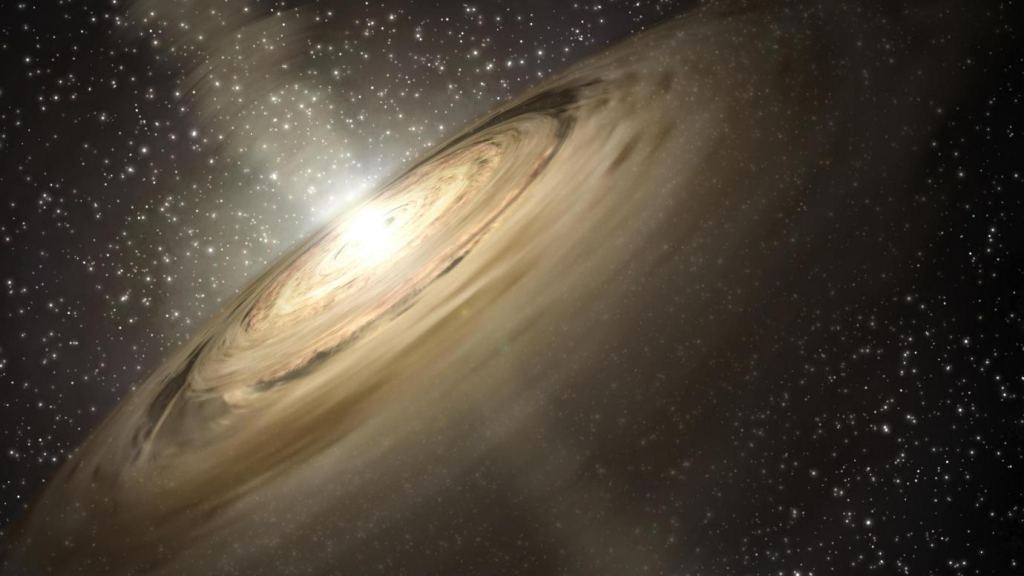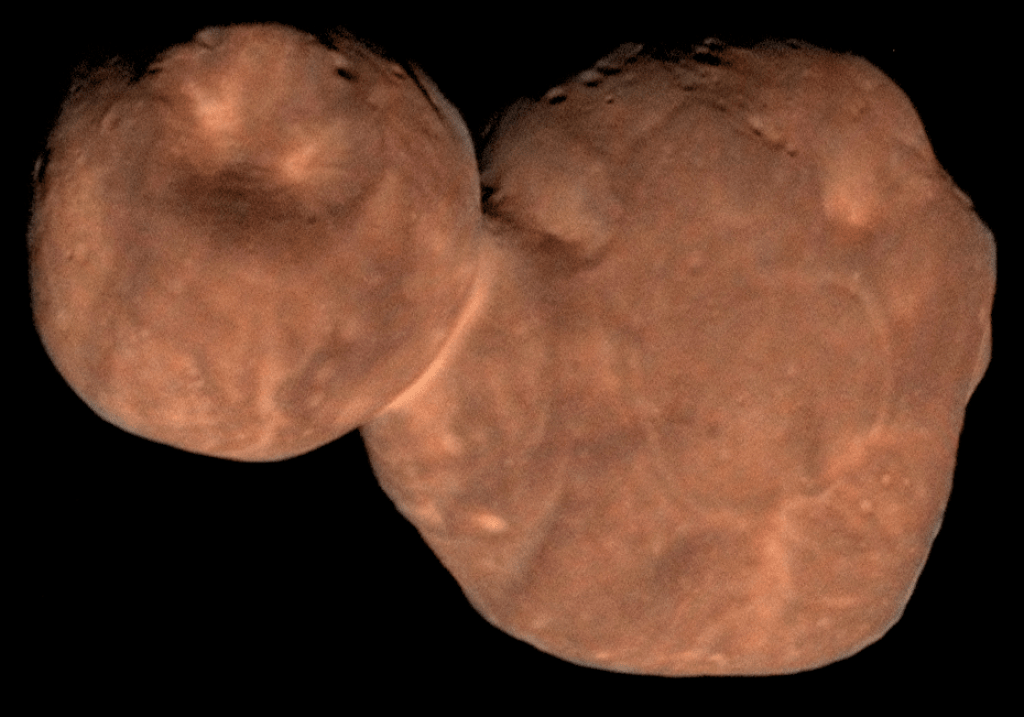Before planets form around a young star, the protosolar disk is populated with innumerable planetesimals. Over time, these planetesimals combine to form planets, and the core accretion theory explains how that happens. But before there are planets, the disk full of planetesimals is a messy place.
The history of rocky objects smashing into each other is written in the craters scarring the surfaces of the planets and moons. But that’s the macro scale of the history. There’s more to planetesimals than their eventual accretion into planets.
New research shows that these small bodies are subject to headwinds made of gas and particles in the protosolar disk that can strike them and throw rocky debris out into space. This is a new wrinkle in our understanding of how rocky planets form.
(A note on terminology: a protosolar disk is the disk of gas and dust that exists while the star at the center is forming. A protoplanetary disk is the same disk after the star has formed but while planets are still forming.)
The study is “Wind erosion and transport on planetesimals.” It’s published in the journal Icarus, and the lead author is Alice Quillen, Professor of Astronomy and Astrophysics at the University of Rochester.
The new study concerns planetesimals between 10 and 100 km in diameter embedded in the protosolar nebula. In these nebulae, the stars are not really stars yet. They’re young stellar objects that don’t undergo any nuclear fusion. So it’s not stellar winds that strike them; it’s the headwinds in the nebula itself. Those headwinds are made of the gas and dust in the disk and arise from the difference in velocity between the material in the disk and the planetesimal. Temperature and pressure differences in different regions of the protosolar disk also contribute.
 A protosolar disk is a disk of material around a young stellar object that isn’t yet a star. It’s called a protoplanetary disk once the star has formed and begun fusion. Planetesimals are the building blocks of planets and are present in both stages of a disk’s evolution. Image Credit: NASA/JPL
A protosolar disk is a disk of material around a young stellar object that isn’t yet a star. It’s called a protoplanetary disk once the star has formed and begun fusion. Planetesimals are the building blocks of planets and are present in both stages of a disk’s evolution. Image Credit: NASA/JPL“We consider the possibility that aeolian (windblown) processes occur on small, 1 to 100 km diameter, planetesimals when they were embedded in the protosolar nebula,” the authors write.
Planetesimals form via cohesion. As small particles collide with each other in the protosolar nebula, they stick together. But a young nebula is a chaotic, messy place. There are collisions which can either add more material to the planetesimals or remove material. Particles and gas can exchange angular momentum, and there’s also gas pressure. There’s a lot going on during this stage, which can last several million years.
Over time, enough particles stick together that a planetesimal takes shape.
But there’s gas pressure in the young disk, and as a planetesimal moves through it, it experiences it as a headwind full of particles. That headwind is strong enough to overcome the planetesimal’s surface cohesion.
“Aeolian (wind-driven) particle transport has occurred on many bodies in the Solar system, including Earth, Mars, Venus, Triton, Titan, Pluto, Io, and comet 67P/ChuryumovGerasimenko,” the authors write. “The ubiquity of aeolian processes in the Solar system suggests that planetesimal surfaces can be modified by protostellar-disk headwinds and the particles within them.”
According to the authors, the headwind in a protostellar disk is powerful enough to loft cm and smaller-sized particles off of planetesimals. This can happen on a planetesimal with a 10 km diameter in the inner Solar System.
Beyond that, in the outer Solar System, something different happens. Particles in the headwinds strike the planetesimals and remove micron-sized particles from the surface. These particles can be thrown into space or distributed back onto the surface of the planetesimal.
For planetesimals below about 6 km in diameter, erosion from particles in the headwind creates mass loss rather than accretion. Factors like wind velocity, headwind particle size, and material size affect the overall process.
The authors point to Arrokoth, a well-known Kuiper Belt Object, as an example. It’s a trans-Neptunian object that probably formed in the outer Solar System. It was likely created when two objects collided at a relatively low velocity. “Amongst Arrokoth’s most striking features are the smooth and undulating terrain present on its larger lobe (or head), also called Wenu,” the authors write.
Arrokoth is not only a trans-Neptunian object; it’s a Jupiter family comet. These comets began as Kuiper Belt Objects but were pulled into the inner Solar System by the gravity of the large gas giants. While other Jupiter family comets have cliffs, perched boulders, and chasms on their surfaces, Arrokoth’s surface is strangely smooth in comparison. Evidence shows that Arrokoth formed when the disk around the young stellar object that would become the Sun was optically thick. So its surface was unaffected by the luminosity coming from the young Sun. That indicates that another process shaped its surface.
“Winds from a protostellar disk could account for Kuiper Belt Object (486958) Arrokoth’s smooth undulating terrain,” they write, but only when there were a lot of particles and only when their velocity was low.
 This composite image of the Kuiper Belt object 2014 MU69 (Arrokoth) came from data obtained by NASA’s New Horizons spacecraft as it flew by the object on Jan. 1, 2019. The authors of the new paper say that the headwind in the protosolar nebula could be responsible for Arrokoth’s smooth, undulating terrain. Credits: NASA/Johns Hopkins University Applied Physics Laboratory/Southwest Research Institute//Roman Tkachenko
This composite image of the Kuiper Belt object 2014 MU69 (Arrokoth) came from data obtained by NASA’s New Horizons spacecraft as it flew by the object on Jan. 1, 2019. The authors of the new paper say that the headwind in the protosolar nebula could be responsible for Arrokoth’s smooth, undulating terrain. Credits: NASA/Johns Hopkins University Applied Physics Laboratory/Southwest Research Institute//Roman TkachenkoThis research is extremely detailed. But overall, it shows that aeolian processes can alter the surfaces of planetesimals and play a role in the planet formation process. There are many variables involved, like headwind velocity, gas pressure, particle size, and planetesimal velocity. Sometimes, the particles are removed from the planetesimal; sometimes, they splash back onto the surface.
The main variable is distance from the protostar. It plays a big role in the process. “The erosion or accretion rates are higher in the inner solar system where the density of the disk is higher,” the authors write.
“Interactions between particle-rich headwinds and planetesimals are likely to cause a variety of interesting phenomena which could be the focus of future studies,” the authors conclude.

